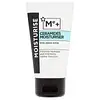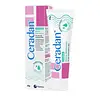What's inside
What's inside
 Key Ingredients
Key Ingredients

 Benefits
Benefits

 Concerns
Concerns

 Ingredients Side-by-side
Ingredients Side-by-side

Water
Skin ConditioningAluminum Starch Octenylsuccinate
AbsorbentGlycerin
HumectantPropylene Glycol
HumectantCetearyl Alcohol
EmollientPropanediol
SolventGlyceryl Stearate
EmollientButylene Glycol
HumectantSorbitan Stearate
EmulsifyingDimethicone
EmollientIsohexadecane
EmollientSodium Polyacrylate
AbsorbentPhenoxyethanol
PreservativeBetaine
HumectantCaprylyl Glycol
EmollientXanthan Gum
EmulsifyingPEG-100 Stearate
Sodium Lauroyl Lactylate
EmulsifyingSodium PCA
HumectantSodium Lactate
BufferingDisodium EDTA
Sodium Hyaluronate
HumectantTocopheryl Acetate
AntioxidantArginine
MaskingAspartic Acid
MaskingPCA
HumectantCeramide NP
Skin ConditioningGlycine
BufferingAlanine
MaskingCholesterol
EmollientCeramide AP
Skin ConditioningPhytosphingosine
Skin ConditioningSerine
MaskingValine
MaskingCarbomer
Emulsion StabilisingEthylhexylglycerin
Skin ConditioningIsoleucine
Skin ConditioningProline
Skin ConditioningThreonine
Histidine
HumectantPhenylalanine
MaskingCeramide EOP
Skin ConditioningWater, Aluminum Starch Octenylsuccinate, Glycerin, Propylene Glycol, Cetearyl Alcohol, Propanediol, Glyceryl Stearate, Butylene Glycol, Sorbitan Stearate, Dimethicone, Isohexadecane, Sodium Polyacrylate, Phenoxyethanol, Betaine, Caprylyl Glycol, Xanthan Gum, PEG-100 Stearate, Sodium Lauroyl Lactylate, Sodium PCA, Sodium Lactate, Disodium EDTA, Sodium Hyaluronate, Tocopheryl Acetate, Arginine, Aspartic Acid, PCA, Ceramide NP, Glycine, Alanine, Cholesterol, Ceramide AP, Phytosphingosine, Serine, Valine, Carbomer, Ethylhexylglycerin, Isoleucine, Proline, Threonine, Histidine, Phenylalanine, Ceramide EOP
Water
Skin ConditioningHydrogenated Polydecene
EmollientSimmondsia Chinensis Seed Oil
EmollientButylene Glycol
HumectantCyclopentasiloxane
EmollientGlycerin
HumectantBehenyl Alcohol
EmollientGlyceryl Stearate
EmollientPEG-60 Glyceryl Isostearate
Cetyl Alcohol
EmollientPentylene Glycol
Skin ConditioningTrideceth-12
EmulsifyingSodium Lauroyl Lactylate
EmulsifyingSorbitan Stearate
EmulsifyingBeeswax
Emulsion StabilisingDimethicone
EmollientPEG-32
HumectantPEG-6
HumectantHydroxypropyl Bispalmitamide Mea
EmollientPhenoxyethanol
PreservativeCarbomer
Emulsion StabilisingEthylhexylglycerin
Skin ConditioningCholesterol
EmollientLinoleic Acid
CleansingTocopherol
AntioxidantXanthan Gum
EmulsifyingSodium Hyaluronate
HumectantSodium Hydroxide
BufferingWater, Hydrogenated Polydecene, Simmondsia Chinensis Seed Oil, Butylene Glycol, Cyclopentasiloxane, Glycerin, Behenyl Alcohol, Glyceryl Stearate, PEG-60 Glyceryl Isostearate, Cetyl Alcohol, Pentylene Glycol, Trideceth-12, Sodium Lauroyl Lactylate, Sorbitan Stearate, Beeswax, Dimethicone, PEG-32, PEG-6, Hydroxypropyl Bispalmitamide Mea, Phenoxyethanol, Carbomer, Ethylhexylglycerin, Cholesterol, Linoleic Acid, Tocopherol, Xanthan Gum, Sodium Hyaluronate, Sodium Hydroxide
 Reviews
Reviews

Ingredients Explained
These ingredients are found in both products.
Ingredients higher up in an ingredient list are typically present in a larger amount.
Butylene Glycol (or BG) is used within cosmetic products for a few different reasons:
Overall, Butylene Glycol is a safe and well-rounded ingredient that works well with other ingredients.
Though this ingredient works well with most skin types, some people with sensitive skin may experience a reaction such as allergic rashes, closed comedones, or itchiness.
Learn more about Butylene GlycolCarbomer is a polymer of acrylic acid. Its main role is to create a gel consistency.
A high amount of carbomer can cause pilling or balling up of products. Don't worry, most products contain 1% or less of carbomer.
Cholesterol is a class of organic molecules called lipids. It helps hydrate your skin and is essential to having a healthy skin barrier.
Our skin naturally contains cholesterol in the outermost layer. Besides cholesterol, it also contains ceramides and fatty acids. Cholesterol makes up about 1/4 of your skin's outer layer and barrier. Your skin barrier is responsible for keeping allergens and microbes out. Having a healthy skin barrier is also responsible for keeping your skin firm and plump.
Our bodies use cholestrol to create vitamin D, steroid hormones, and more.
Learn more about CholesterolDimethicone is a type of synthetic silicone created from natural materials such as quartz.
What it does:
Dimethicone comes in different viscosities:
Depending on the viscosity, dimethicone has different properties.
Ingredients lists don't always show which type is used, so we recommend reaching out to the brand if you have questions about the viscosity.
This ingredient is unlikely to cause irritation because it does not get absorbed into skin. However, people with silicone allergies should be careful about using this ingredient.
Note: Dimethicone may contribute to pilling. This is because it is not oil or water soluble, so pilling may occur when layered with products. When mixed with heavy oils in a formula, the outcome is also quite greasy.
Learn more about DimethiconeEthylhexylglycerin (we can't pronounce this either) is commonly used as a preservative and skin softener. It is derived from glyceryl.
You might see Ethylhexylglycerin often paired with other preservatives such as phenoxyethanol. Ethylhexylglycerin has been found to increase the effectiveness of these other preservatives.
Glycerin is already naturally found in your skin. It helps moisturize and protect your skin.
A study from 2016 found glycerin to be more effective as a humectant than AHAs and hyaluronic acid.
As a humectant, it helps the skin stay hydrated by pulling moisture to your skin. The low molecular weight of glycerin allows it to pull moisture into the deeper layers of your skin.
Hydrated skin improves your skin barrier; Your skin barrier helps protect against irritants and bacteria.
Glycerin has also been found to have antimicrobial and antiviral properties. Due to these properties, glycerin is often used in wound and burn treatments.
In cosmetics, glycerin is usually derived from plants such as soybean or palm. However, it can also be sourced from animals, such as tallow or animal fat.
This ingredient is organic, colorless, odorless, and non-toxic.
Glycerin is the name for this ingredient in American English. British English uses Glycerol/Glycerine.
Learn more about GlycerinGlyceryl Stearate is a mix of glycerin and stearic acid.
It is used to stabilize the mixing of water and oil ingredients. By preventing these ingredients from separating, it can help elongate shelf life. It can also help thicken the product's texture.
As an emollient, it helps soften skin and supports barrier-replenishing ingredients.
In cosmetics, Glyceryl Stearate is often made from vegetable oils or synthetically produced.
This ingredient may not be fungal-acne safe
Fun fact: The human body also creates Glyceryl Stearate naturally.
Learn more about Glyceryl StearatePhenoxyethanol is a preservative that has germicide, antimicrobial, and aromatic properties. Studies show that phenoxyethanol can prevent microbial growth. By itself, it has a scent that is similar to that of a rose.
It's often used in formulations along with Caprylyl Glycol to preserve the shelf life of products.
Sodium Hyaluronate is hyaluronic acid's salt form. It is commonly derived from the sodium salt of hyaluronic acid.
Like hyaluronic acid, it is great at holding water and acts as a humectant. This makes it a great skin hydrating ingredient.
Sodium Hyaluronate is naturally occurring in our bodies and is mostly found in eye fluid and joints.
These are some other common types of Hyaluronic Acid:
Learn more about Sodium HyaluronateSodium Lauroyl Lactylate is the lauric acid sodium salt of lactyl lactate.
Sodium Lauroyl Lactylate is an emulsifier and surfactant.
Emulsifiers help stabilize a product. They do this by preventing ingredients from separating, such as oils and water which do not mix naturally. Surfactants reduce surface tension, making it easier to rinse pollutants off skin.
Due to its relation to lauric acid, it may provide antimicrobial benefits.
Learn more about Sodium Lauroyl LactylateSorbitan Stearate comes from sorbitol and stearic acid. Sorbitol is a type of sugar and stearic acid is a fatty acid.
It is used as an emulsifier and helps ingredients stay together by creating water-in-oil emulsions.
This ingredient may not be Malassezia folliculitis, or fungal-acne safe.
Water. It's the most common cosmetic ingredient of all. You'll usually see it at the top of ingredient lists, meaning that it makes up the largest part of the product.
So why is it so popular? Water most often acts as a solvent - this means that it helps dissolve other ingredients into the formulation.
You'll also recognize water as that liquid we all need to stay alive. If you see this, drink a glass of water. Stay hydrated!
Learn more about WaterXanthan gum is used as a stabilizer and thickener within cosmetic products. It helps give products a sticky, thick feeling - preventing them from being too runny.
On the technical side of things, xanthan gum is a polysaccharide - a combination consisting of multiple sugar molecules bonded together.
Xanthan gum is a pretty common and great ingredient. It is a natural, non-toxic, non-irritating ingredient that is also commonly used in food products.
Learn more about Xanthan Gum